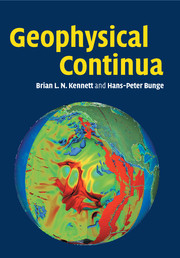Book contents
- Frontmatter
- Contents
- Preface
- 1 Introduction
- PART I CONTINUUM MECHANICS IN GEOPHYSICS
- PART II EARTH DEFORMATION
- 9 From the Atomic Scale to the Continuum
- 10 Geological Deformation
- 11 Seismology and Earth Structure
- 12 Lithospheric Deformation
- 13 The Influence of Rheology: Asthenosphere to the Deep Mantle
- 14 Mantle Convection
- 15 The Core and the Earth's Dynamo
- Appendix: Table of Notation
- Bibliography
- Index
13 - The Influence of Rheology: Asthenosphere to the Deep Mantle
from PART II - EARTH DEFORMATION
Published online by Cambridge University Press: 17 March 2011
- Frontmatter
- Contents
- Preface
- 1 Introduction
- PART I CONTINUUM MECHANICS IN GEOPHYSICS
- PART II EARTH DEFORMATION
- 9 From the Atomic Scale to the Continuum
- 10 Geological Deformation
- 11 Seismology and Earth Structure
- 12 Lithospheric Deformation
- 13 The Influence of Rheology: Asthenosphere to the Deep Mantle
- 14 Mantle Convection
- 15 The Core and the Earth's Dynamo
- Appendix: Table of Notation
- Bibliography
- Index
Summary
The contrast in behaviour between the lithosphere with stress transmission and the asthenosphere with flow linked to the mantle convection system represents one of the distinctions that can be made between different parts of the Earth through the nature of intrinsic rheology. However, we have to use indirect information to gain information on the change with depth.
A further major contrast in rheological properties in the near surface arises from the process of subduction where former oceanic lithosphere penetrates through the mantle transition zone to interact with the phase boundary at 660 km and the significant increase of mantle viscosity in the same neighbourhood.
A major control on rheology in Earth's mantle is likely to be the influence of temperature, but this will be accentuated by the effect of other variables such as grain size, which can at best be inferred indirectly.
Little is known of the rheology of materials under the pressure and temperature conditions prevailing at the base of the mantle, but the complexities of the D″ layer suggest that contrasts in physical properties comparable to those seen at the surface may well prevail. The D″ layer has distinct, but somewhat variable, seismic anisotropy that suggests a range of different deformation conditions.
- Type
- Chapter
- Information
- Geophysical ContinuaDeformation in the Earth's Interior, pp. 294 - 329Publisher: Cambridge University PressPrint publication year: 2008



